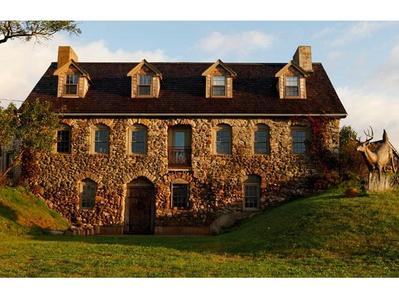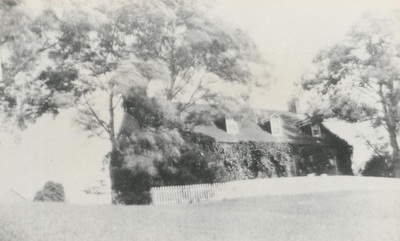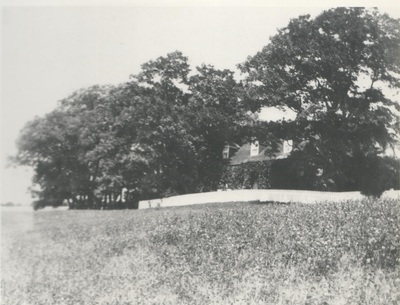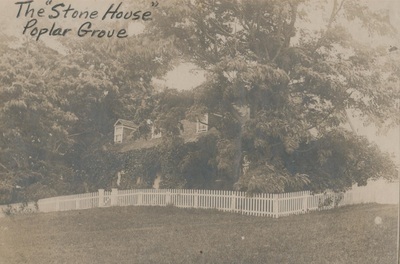
The French presence in Nova Scotia began when the Frenchman Pierre Dugua established a settlement in 1605 at Port-Royal. Over the course of the century more and more French families immigrated to Acadia, especially in the Annapolis Valley with the hopes of settling the rich farmland. Acadian farmers dug dykes to protect their pastures from being flooded on account of the widely varying tides of the Bay of Fundy. Remnants of these dykes can still be seen around the Annapolis Valley, particularly just outside of Wolfville near Grand Pré.
Hants County (known to the Acadians as “les Mines”) was home to a number of families, such as the Thibodeaus, Landrys, and Babins, who had settled by the river Pisiguit, known today as the Avon River.
Unfortunately life could be difficult for the Acadians; their lives were overshadowed by various power struggles between the British and French, both wanting control over the region. The final swap of power in 1713 led to Acadia being under the control of the British and ultimately to the expulsion of the Acadians in 1755 due to fears and suspicions that the Acadians might try to fight for France. Ironically, a similar situation arose during the American Revolution, during which the Planters were held under suspicion by the British due to their American heritage.
The Acadians were deported to various regions all around the world such as Louisiana, New England, France, and several islands in the Caribbean. They were allowed to return to Nova Scotia in 1763 though most of their former land was occupied. Place names, dykes, monuments, and family names attest to the prior Acadian presence in the Annapolis Valley.
The building shown in these photographs is The Mission of Avondale, part of which some believe was built by Acadians in 1699 for missionary work, if this proves true it would have the distinction of being the oldest house in Nova Scotia.
According to it's current owner, famous photographer Sherman Hines, in 1755 it was owned by the King of England and in 1760 was transferred to two young men, Aaron Butts and George Brightman. Some credit John Chambers with building the house known as "the Old Stone House" in 1761.
Since then it has passed into the hands of numerous owners until it was purchased by Mr. and Mrs. Hines in 1980 for $15,000. Together they have refurbished the building using period materials. Over the years, Mr. Hines has added several other buildings to the property, including the Poplar Grove Church.
Hants County (known to the Acadians as “les Mines”) was home to a number of families, such as the Thibodeaus, Landrys, and Babins, who had settled by the river Pisiguit, known today as the Avon River.
Unfortunately life could be difficult for the Acadians; their lives were overshadowed by various power struggles between the British and French, both wanting control over the region. The final swap of power in 1713 led to Acadia being under the control of the British and ultimately to the expulsion of the Acadians in 1755 due to fears and suspicions that the Acadians might try to fight for France. Ironically, a similar situation arose during the American Revolution, during which the Planters were held under suspicion by the British due to their American heritage.
The Acadians were deported to various regions all around the world such as Louisiana, New England, France, and several islands in the Caribbean. They were allowed to return to Nova Scotia in 1763 though most of their former land was occupied. Place names, dykes, monuments, and family names attest to the prior Acadian presence in the Annapolis Valley.
The building shown in these photographs is The Mission of Avondale, part of which some believe was built by Acadians in 1699 for missionary work, if this proves true it would have the distinction of being the oldest house in Nova Scotia.
According to it's current owner, famous photographer Sherman Hines, in 1755 it was owned by the King of England and in 1760 was transferred to two young men, Aaron Butts and George Brightman. Some credit John Chambers with building the house known as "the Old Stone House" in 1761.
Since then it has passed into the hands of numerous owners until it was purchased by Mr. and Mrs. Hines in 1980 for $15,000. Together they have refurbished the building using period materials. Over the years, Mr. Hines has added several other buildings to the property, including the Poplar Grove Church.
La présence française en Nouvelle-Écosse a commencé quand le Français Pierre Dugua a établi une implantation en 1605 à Port-Royal. Au cours du siècle de plus en plus de familles françaises ont immigré en Acadie, en particulier dans la vallée de l'Annapolis avec l'espoir de s’installer dans les terres agricoles riches. Les fermiers acadiens ont creusé des digues pour protéger leurs pâturages d'être inondées à cause des marées très variables de la baie de Fundy. Les restes de ces digues peuvent encore être vus autour de la vallée de l'Annapolis, en particulier à l'extérieur de Wolfville près de Grand Pré.
Hants County (connu par les Acadiens comme « les Mines ») était à la maison à un certain nombre de familles, comme les Thibodeaus, Landrys et Babins, qui avait s’installé près de la rivière Pisiguit, connu aujourd'hui comme la rivière Avon.
Malheureusement, la vie peut être difficile pour les Acadiens; leurs vies ont été éclipsées par diverses luttes de pouvoir entre les Britanniques et les Français, les deux voulant le contrôle sur la région. Le dernier échange de pouvoir en 1713 a mené à l’Acadie étant sous le contrôle des Britanniques et, finalement, à l'expulsion des Acadiens en 1755 en raison de craintes et la suspicion que les Acadiens pourraient essayer de se battre pour la France. Ironiquement, une situation similaire se produit pendant la Révolution Américaine, au cours de laquelle les planteurs ont été suspectés par les Britanniques en raison de leur héritage américain.
Les Acadiens ont été déportés dans différentes régions dans le monde entier comme la Louisiane, la Nouvelle-Angleterre, la France, et plusieurs îles des Caraïbes. Ils ont été autorisés à retourner en Nouvelle-Écosse en 1763 bien que la plupart de leurs anciennes terres était occupé. Les noms de lieux, les digues, les monuments et les noms de famille témoignent de la présence acadienne avant dans la vallée de l'Annapolis.
Le bâtiment montré dans ces photographies est la mission d’Avondale, quelques croient qu’une partie a été construit par les Acadiens en 1699 pour le travail missionnaire, et si c’est vrai c’est la plus ancienne maison en Nouvelle-Écosse.
Selon son propriétaire actuel, photographe célèbre Sherman Hines, en 1755 elle était possédée par le Roi d’Angleterre et en 1760 était transféré aux deux jeunes hommes, Aaron Butts et George Brightman. Quelques créditent John Chambers avec la construction de la maison connu comme « la Vielle Maison en Pierre » en 1761.
Depuis lors elle était passée dans les mains de plusieurs propriétaires jusqu’à elle était acheté par M. et Mme. Hines en 1980 pour 15 000$. Ils ont ensemble rénové le bâtiment utilisant les matériaux périodes. Au fil des ans, M. Hines avait ajouté plusieurs autres bâtiments à la propriété, qui inclue l’église de Poplar Grove.


